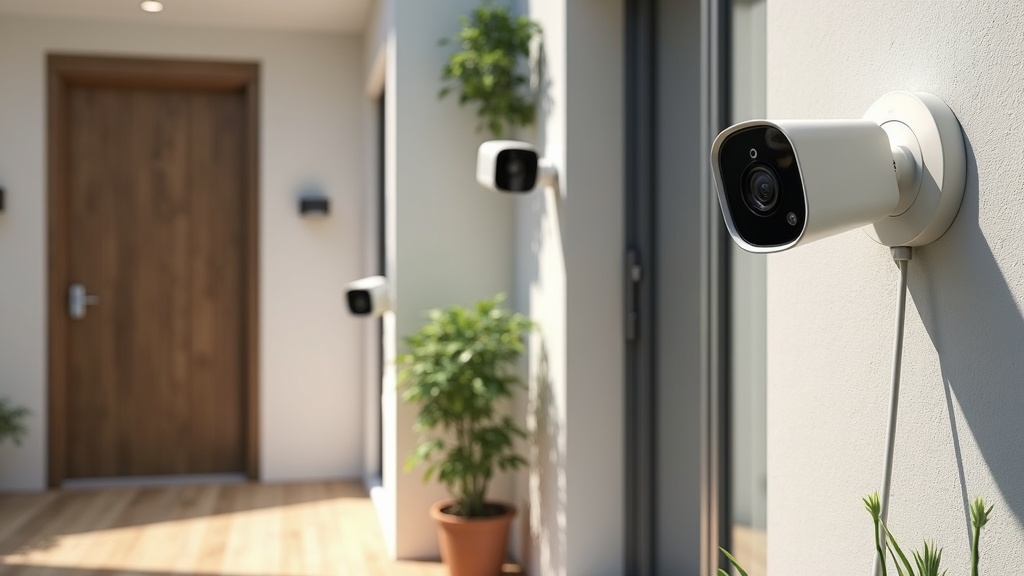Picking smart cameras for your home can make a big difference in how secure you feel day to day. There are so many choices now, and every home setup is a little different. Are you feeling a little lost sorting through brands, camera types, and features? Don’t worry, you’re not alone. I’m going to walk you through what actually matters, boil down the tech talk, and share what works so you can find smart cameras that truly fit your needs.

Why Smart Cameras Are Really Worth Considering
Gone are the days when smart cameras just captured fuzzy video. Now, they connect easily to your phone, use AI for motion alerts, and even help you talk to delivery drivers when you’re not at home. There’s been a surge in popularity for good reason; smart security cameras are getting easier to use, more reliable, and cheaper. No wonder lots of families and renters are adding them to keep an eye on things or answer the door from the office.
But smart cameras aren’t just for security. Parents use them to check in on kids arriving home from school, and pet owners monitor furry friends. Some models even work with smart home routines, like triggering lights if motion is detected, so you get flexibility and peace of mind.
Beyond the basics, some smart cameras come with next-level cool features like built-in sirens, facial recognition, or the ability to automatically call emergency services if certain types of motion are detected. These babies are useful tools in a wide variety of everyday situations, not just break-ins or suspicious activities. Even if you work from home, these cameras can offer practical benefits, allowing you to monitor package deliveries, interact with visitors, or just double-check unusual noises without leaving your workspace.
What To Look For In Smart Home Cameras
Picking the right security camera really depends on your space, WiFi setup, and what you want to keep an eye on. Here are the details you should pay attention to:
- Image Quality: These days, 1080p (HD) is the standard, but if you want crisp detail for faces or license plates, 2K or 4K cameras are worth a look.
- Field of View: Wider lenses (like 130 degrees or more) let you cover more area without needing extra cameras.
- Night Vision: Infrared is common, but you can get “color night vision” for those darker corners.
- Smart Alerts: Some cameras distinguish between people, pets, and vehicles. This cuts down on annoying notifications every time a squirrel runs by.
- Audio: Two-way audio lets you hear and talk to either visitors or unwanted guests straight from your phone.
- Integration: If you use Google Home, Alexa, or Apple HomeKit, make sure your new cameras play nicely with your existing devices.
If you prioritize your privacy, some smart cameras come with physical lens covers or built-in “privacy mode” options. These allow you to turn off recording or streaming when you’re home, so you get security outside and real peace of mind inside. Also, it’s worth checking if the camera supports customizable motion zones. This way, you can fine-tune areas of interest, like your driveway or back porch, and ignore the street or neighbor’s yard to avoid too many alerts.
Wired vs. Wireless Cameras: What’s Better?
Both wired and wireless smart cameras have their pros and cons, and neither is strictly better for everyone. Here’s how I see the trade-offs:
- Wired Cameras: These need a constant power connection and usually an Ethernet line. They’re super reliable; no batteries to swap and no WiFi drop-outs. Installation can be tricky, though, since you might need to run cables through walls or ceilings.
- Wireless Cameras: These connect to your WiFi and run on batteries (some are plugin but wireless for data). They’re much easier to install and good for renters or anyone wanting quick setup. Battery life varies; some last a few weeks, others for months, depending on usage and whether they record constantly or just on motion.
If you want a “set it and forget it” setup and don’t mind hiring an installer or dealing with cables, wired cameras are pretty handy. But if flexibility, easy DIY install, or moving your cameras around matters, wireless cameras are the way to go.
Some folks prefer a mix of both: wired for primary coverage like front doors and wireless for less accessible places. This hybrid approach makes it easy to tailor your setup to your needs, ensuring coverage while keeping installation time and costs reasonable.
Popular Smart Home Camera Systems That Deserve A Look
Some camera systems consistently get great reviews and seem to pop up in conversations across forums and user groups. Here are a few brands you could start your search with:
- Arlo: Known for top-notch wireless cameras with great image quality, flexible mounts, and solid app support. Also a solid battery life.
- Google Nest: Great for all-in-one smart home setups and seamless Google Assistant integration. Their indoor and outdoor cameras have next-level cool software and reliable alerts.
- Ring: Super popular for doorbells and easy DIY installs, plus handy integration with Amazon Alexa devices. Neighborhood security features and sharing are neat for community-minded folks.
- Eufy: Offers well-reviewed, affordable cameras with local video storage, so you’re not locked into a subscription.
Everyone’s “best” will be a little different. If you’re deep in the Apple HomeKit ecosystem, for example, brands like Logitech Circle View are worth checking out. My advice? Think through which ecosystem you prefer and make sure the features line up with how you want to use your cameras. Also, research how their data storage works; some companies focus on cloud storage while others let you backup locally for more control.
How To Choose A Wireless Security Camera
Sorting through all the wireless camera specs can feel overwhelming, so here’s a good checklist:
- Check Internet Speed: Wireless cameras need solid WiFi. Upload speeds matter more than downloads, since that’s what’s pushing footage out to the cloud. If your router is old, upgrade it for smoother streaming.
- Decide On Battery Or Plug-In: Are you okay climbing a ladder every couple of months to recharge batteries? Plugin models dodge this hassle, but you need an outlet.
- Look For Adjustable Motion Zones: Being able to customize which part of the camera’s view triggers a recording is super helpful. This avoids endless false alerts from cars driving past your house.
- Storage: Will video footage go to the cloud (which might need a subscription) or will you use an SD card for local storage? A good idea would be a setup with backup storage just in case your Internet ever goes out.
Don’t rush into buying a whole set—start small and scale up as you learn what works in your environment.
How To Select The Right Security Camera In General
The main thing is figuring out what problem you want your cameras to solve. Here’s a basic step by step process:
- Map Out Coverage Areas: Walk around your property and jot down high-risk spots (front door, backyard, side gate). Pick the spots that matter most first.
- Check Lighting: Bright sunlight, deep shade, or nighttime coverage? Get cameras built for your conditions. Bad lighting can make even a fancy camera pretty useless.
- Plan Your Budget: Decide if you want a couple of high-end cameras or more budget-friendly ones in every corner. Don’t forget to factor in possible subscription or local storage costs.
- Double Check Compatibility: Only choose cameras that fit with your smart home system and phone. Mixing brands can lead to annoying compatibility issues and extra apps.
The right choice is the one that covers your unique needs, not just the one with the most “smart” features. Careful research and reading real user reviews (especially those with photos in conditions similar to yours) really pays off here. Sometimes, reaching out in online forums or home tech groups can reveal hidden gems or common issues that don’t show up in product pages.
Extra Tips For A Secure, Reliable Camera Setup
Once you have your gear picked out, some quick tricks can help you get the most out of your new cameras:
- Position Cameras High And Visible: Not only does this give a better field of view, but it can also act as a deterrent to unwanted visitors.
- Test Angles With Your App: Use the live view feature in your camera’s app to fine-tune positioning. You can save yourself a lot of readjusting by spending 15 minutes on this when installing.
- Stay Up To Date: Promptly install camera firmware and app updates. These often fix bugs or patch security loopholes.
- Look For Privacy Features: Some cameras have physical shutters or privacy “off” modes. That’s nice to have for peace of mind if you want to turn off indoor cameras while you’re home.
For extra protection, consider setting up custom alert schedules. This lets you automatically arm or disarm cameras depending on your daily routines, cutting down on needless notifications and giving you better control over your privacy. Some advanced setups even allow for geofencing–automatically switching cameras on or off when your phone enters or leaves your home area.
Frequently Asked Questions About Smart Home Cameras
Is it better to have wired or wireless security cameras?
Both wired and wireless cameras serve different needs. Wired options give constant, stable footage without worries about batteries or WiFi reliability, which works great for permanent installs. Wireless cameras make installation a breeze and are perfect for renters or those who like to move cameras around. A mix of both types is common in bigger homes. Lean toward wireless for flexibility, but wired is still a reliable choice when you can set it up.
What is the best smart home camera system?
Popular picks include Arlo and Google Nest for all-around features and integration, while Eufy shines if you want to avoid monthly fees. The “best” camera system depends on what ecosystem you use at home (Alexa, Google, Apple), your budget, and the features you care about, like local storage or smart motion alerts.
How do I choose a wireless security camera?
Check that your WiFi is strong enough where you want to mount the camera, consider battery life, and look for smart features like adjustable alerts and app access. It’s worth starting with one or two cameras, testing them out in your space, and scaling up if you like how they work.
How to select a security camera?
Think about what you want to watch, pick cameras that work with your existing smart home hardware (if any), and decide on your preferred balance between price and features. Read lots of user reviews—especially from people with similar property layouts—before you click “buy.”
Getting The Most Out Of Smart Cameras At Home
Setting up a home camera system can feel like a lot, but breaking it down into these steps makes it manageable. Narrow down exactly what you want to cover, pick cameras built for your unique spots, and don’t forget to double-check app compatibility. With a little up-front planning and smart placement, you’re on your way to a safer, smarter home in no time. Security doesn’t have to be intimidating; just practical, thoughtful, and tailored to your everyday life. And as these technologies keep spreading, it’s easier than ever to step up your home protection in a way that fits your lifestyle and budget.
